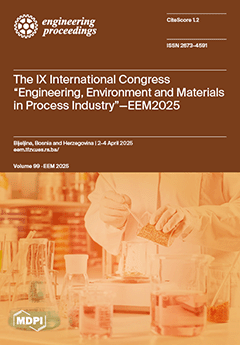Eng. Proc., 2025, EEM 2025
The IX International Congress “Engineering, Environment and Materials in Process Industry”—EEM2025
Bijeljina, Bosnia and Herzegovina | 2–4 April 2025
Volume Editors:
Dragan Vujadinović, University of East Sarajevo, Bosnia and Herzegovina
Milorad Tomić, University of East Sarajevo, Bosnia and Herzegovina
Vesna Gojković Cvjetković, University of East Sarajevo, Bosnia and Herzegovina
Milan Vukić, University of East Sarajevo, Bosnia and Herzegovina
Milenko Smiljanić, University of East Sarajevo, Bosnia and Herzegovina
Mitar Perušić, University of East Sarajevo, Bosnia and Herzegovina
- Issues are regarded as officially published after their release is announced to the table of contents alert mailing list.
- You may sign up for e-mail alerts to receive table of contents of newly released issues.
- PDF is the official format for papers published in both, html and pdf forms. To view the papers in pdf format, click on the "PDF Full-text" link, and use the free Adobe Reader to open them.




